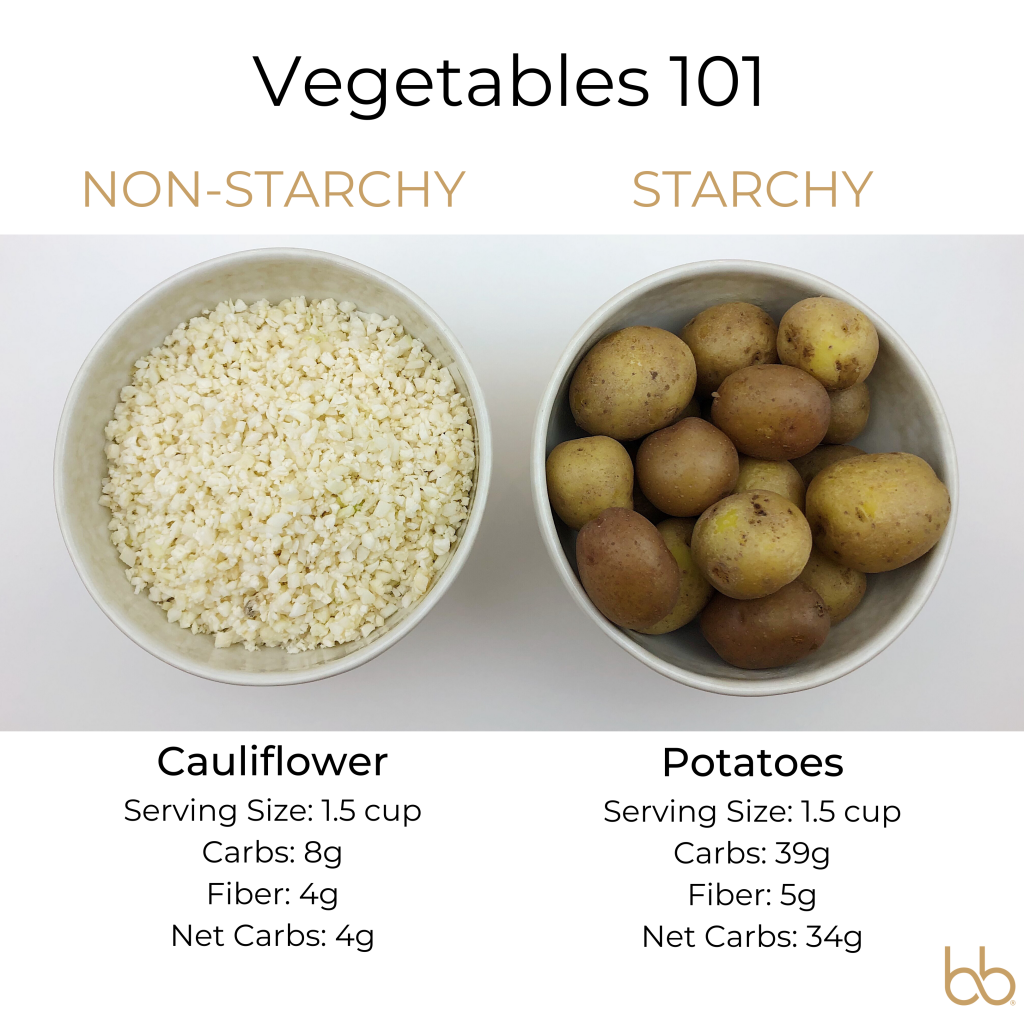
Carbohydrates are not inherently bad, especially when considering that vegetables are a carbohydrate! But the discussion should really be around distinguishing between the two groups of vegetables that have very different impacts on blood sugar levels: starchy and non-starchy. And America’s favorite vegetable that is consumed most often falls, the potato, under the starchy category.
But is the nutritional value of a potato really comparable to the nutritional value of cauliflower? Definitely not–especially when it comes to the impact that each of these vegetables have on your blood sugar levels. Hence why cauliflower rice has become such a popular substitute for potatoes.

There are two categories of vegetables, as it related to the impact on blood sugar levels: Non-Starchy and Starchy. One category is not better than the other but it’s important to understand the differences so that you know which to load up on more often. This is especially relevant to those who are working on improving insulin sensitivity, blood sugar balance, weight loss and longevity.
Non-Starchy Vegetables
Non-starchy vegetables are the group of vegetables that you want to eat in abundance. I generally recommend aiming for filling half of your plate with this group of vegetables at meals, unless you have GI symptoms from eating more vegetables (see article on bloating). Now, of course this isn’t always possible but aim for doing this as often as you can. As a person’s non-starchy vegetable intake goes up, their risk of stroke, heart disease, weight gain, type 2 diabetes, and pre-diabetes decreases.
One cup of each of non-starchy vegetables contains about 5-10 grams of carbohydrates, which is much lower than the starchy vegetable group. This does not mean that carbohydrates are bad. But when structuring your plate, you want the base of the plate to come from foods that provide lots of fiber, antioxidants, vitamins and minerals for very little energy. This is called nutrient density and non-starchy vegetables are extremely nutrient-dense. And that’s why we want them at the base of your plate!
Here is a List of Non-Starchy Vegetables:
Arugula
Artichokes
Asparagus
Artichokes
Asparagus
Bean sprouts
Beet greens
Bell peppers
Bok choy
Broccoli
Broccoli sprouts
Brussels sprouts
Cabbage
Cauliflower
Celery
Collard greens
Cucumber
Dandelion greens
Eggplant
Endive
Fennel
Green beans
Hearts of palm
Jalapeno pepper
Kale
Lettuce (all)
Mushrooms
Mustard greens
Onions
Pumpkin
Radishes
Radicchio
Snap beans
Snow peas
Shallots
Spinach
Spaghetti squash
Swiss chard
Tomatoes
Turnip greens
Watercress
Zucchini
Starchy Vegetables
Starchy vegetables are the second group. These vegetables are also rich in fiber, antioxidants, vitamins and minerals. However, getting the same amount of nutrients from starchy vegetables comes with more energy (calories) and carbohydrates. Calories and carbohydrates are not inherently ‘bad’. But if you filled half of your plate with starchy vegetables at every meal versus non-starchy vegetables, you would see very different outcomes in your blood sugar, insulin and weight.
I still encourage people to consume starchy vegetables, generally 1/2 cup-1 cup, but don’t count them as your vegetable. Count them as your starch. Potatoes and apples are much more comparable to each other than potatoes and cauliflower or broccoli.
Here is a Breakdown of Starchy Vegetables:
Parsnips: 1 cup slices: 24g CHO & 7g Fiber
Acorn squash: 1 cup cubes: 15g CHO & 2g Fiber
Butternut squash: 1 cup cubes: 16g CHO & 3g Fiber
Corn: 1/2 cup kernels: 15g CHO & 2g Fiber
Plantains: 1/2 cup slices: 24g CHO & 2g Fiber
Potato: 1/2 medium: 17g CHO & 3g Fiber
Sweet potato: 1 cup: 27g CHO & 4g Fiber
Beets: 1 cup: 13g CHO & 4g Fiber
Carrots: 1 cup: 12g CHO & 4g Fiber
Rutabaga: 1 cup: 12g CHO & 3g Fiber
Celeriac: 1 cup: 14g CHO & 3g Fiber
The Takeaway Message
The takeaway message is simple: load up half of your plate with non-starchy vegetables. This is the group that you can eat as much as you want, assuming that you don’t get negative GI symptoms from too much fiber. Count your non-starchy vegetables as a starch and be conscious of how much you are loading on your plate!
Choosing Vegetables with the Lowest Glycemic Impact
Tired of Feeling Foggy, Bloated, or Depleted?
A complete plan to feel better, built for real life
Over 4 weeks, you'll work with Brigid and her team and get everything you need to reduce inflammation, improve energy, and feel better. No rigid calorie counting. No mystery supplements.
Just a system that makes sense and support that sticks.
Meet The Being Collective
Resources
Join 30,000+ subscribers getting expert guidance to optimize their health and prevent chronic disease